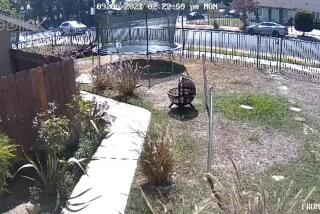The Monitor: ‘Bait Car’ on TruTV
- Share via
Who steals a car? Car thieves, to be sure, which is to say people who make a habit of taking vehicles that don’t belong to them. But how about a father and son or a mother and her two children? What about three young women who’d never met before all hopping in the same stolen SUV, who all exchange names as they’re being pulled over by police?
What the true- crime series “Bait Car” (TruTV, 9 p.m. Tuesdays) aims to demonstrate, sometimes strenuously, is that there is no one sort of car thief.
Except when there is: Those caught in the police stings that make up this show’s segments are disproportionately black and Latino, and several are minors. In clip after clip (several are available on TruTV.com), cars aren’t left on street corners in Beverly Hills or Brentwood but in neighborhoods where crime rates are high and appear to be heavily populated by minorities.
Here’s the game behind this series: A car is abandoned with the engine running or the keys left behind, usually via some sort of elaborate ruse (a false DUI arrest, or an altercation between two parties). But it’s bait: The car is outfitted with cameras and a system that allows for it to be stalled remotely. Eventually — often, if the show is to be believed — someone decides to appropriate it for themselves. That person is filmed in the act, then arrested.
This show’s third season begins this week, with operations in Los Angeles, New Orleans and Las Vegas. (TruTV declined to make screeners of the premiere episodes available.) In small doses, it’s addictive and comical, a blend of hidden-camera prank shows “C.O.P.S.” and “America’s Funniest Videos.”
No one uses the word “entrapment” on this show, and from a legal perspective, that appears to be accurate. Bait cars are used in numerous cities as part of crime-deterrence strategies. On YouTube are plenty of clips from other jurisdictions. (The ones from the Vancouver, Canada, area, also available at BaitCar.com, which is unaffiliated with this show, are among the wackiest and best.) On the show’s website, there’s a perfunctory back-and-forth between a police chief and a defense attorney about whether the method constitutes entrapment or is even ethical, though “Bait Car” clearly lands on the side where it’s permissible.
Still, it’s difficult to watch these operations without feeling a heavy hand of manipulation at work. Some of the thieves appear to have experience, making sure to drive with their hands wrapped in a T-shirt or sock so as to not leave fingerprints. But just as many appear hapless. A theft is a theft is a theft, but it’s hard to get excited about watching a teenager out for a joy ride having guns drawn on him.
Not to mention that where previously there had been no crime, now there is one, with all the secondary risk that comes with that: sloppily driven vehicles in residential neighborhoods, the possibility of gunplay or other violence between the pursued and the pursuers. Shows like this are almost certainly being reconsidered in the wake of the May 16 fatal shooting of Aiyana Stanley-Jones in Detroit during a police raid that was being filmed for the A&E reality show “The First 48.”
Cameras have long had a complicated place in law enforcement. On “Bait Car,” they capture unlikely moments. Faced with the cameras, one frustrated-looking man takes the opportunity to preach: “Stay in school. So many opportunities’ll come once you get that education, man. Once that education come, that’s the key to success. Take it and run with it.” Another one admits that he’s watched “Bait Car” on TV before.
Most intriguing is the footage shot inside the car as it becomes clear to the thieves that the ruse is up. In the case of the father and son mentioned above, it’s a moment of heartbreak: As their car stalls to a stop and the father acknowledges defeat, his son, who is 16, bursts out, “I love you, Dad.”
More to Read
The complete guide to home viewing
Get Screen Gab for everything about the TV shows and streaming movies everyone’s talking about.
You may occasionally receive promotional content from the Los Angeles Times.






